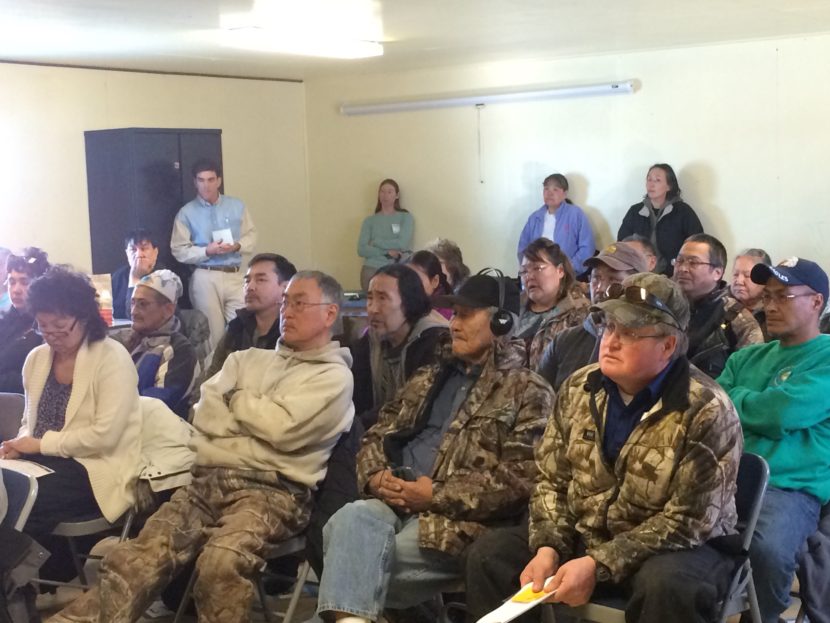
The US Army Corps of Engineers has completed a week of back-to-back meetings collecting public comment on the Donlin Gold draft environmental impact statement, or EIS, with a visit to Nunapitchuk.
The Army Corps is the lead federal agency on the document and has contracted the international environmental and engineering firm AECOM to create the draft.
About 25 people from Nunapitchuk, Kasigluk, and Atmautluak attended the gathering on Thursday to testify on the proposed open pit gold mine located about 10 miles north of the village of Crooked Creek and the Kuskokwim River.
The comments at the meeting remained consistent with concerns expressed in other villages throughout the Yukon-Kuskokwim region on the project; mainly residents want the economic benefits of jobs without assuming the environmental impacts mining could have on subsistence.
But Bobby Hoffman, a Calista Corporation board member, says subsistence users can’t have one without the other.
“If we don’t have money we can’t get subsistence. Since our subsistence is away from our villages and our towns, we have to go get them. Without gas, without equipment— snow machines, shells, food— we can’t get them,” Hoffman said.
Calista owns the mineral rights to the mine site and plans to increase shareholder dividends with revenue generated from its operations—an estimated $1.5 billion over the life of the project and an additional quarter million dollars in right-of-way lease payments from a proposed pipeline, according to the draft EIS.
Nunapitchuk resident Barbara Evan says she’s torn about the mine.
“I know there (are) a lot of unemployed people all over these small rural communities. It’s a good opportunity for them, but then there’s that side where the elders are concerned about our subsistence,” Evan said.
Her son is one of those unemployed people. He’s 21 years old and living at home. She says he dropped out of high school, and she’s encouraging him to get his GED so he can work.
Evan says even though she’s concerned about environmental hazards if the mine offered her son a job, she’d encourage him to take it. And if the mine were operating, she says maybe he wouldn’t be in his situation, because more employment opportunities would motivate young people to finish school.
But Morris Alexie, a subsistence hunter from Nunapitchuk disagrees.
“It’s been 20 years since these guys showed up,” Alexie said. “I haven’t seen any improvements in our graduation rates.”
According to the draft EIS, in 1995 Placer Dome US began exploring the mine site, setting up camps and support facilities like an airstrip and roads to advance their assessments.
In 2007 Barrick Gold North America and NOVAGOLD Resources Alaska, Inc. formed Donlin Creek LLC in a 50/50 partnership. They changed the company’s name to Donlin Gold LLC in 2011.
Since then Donlin has committed to a Calista shareholder hiring preference, and the draft EIS estimates the mine would employ 1,600 to 1,900 YK residents during construction and 500 to 600 residents during operations.
Alexie says those numbers don’t substantially benefit the region.
“They say jobs. But there (are) 13,000 shareholders right now, and if we add the descendants, it’ll be 40,000 shareholders,” he said. “It outweighs the shareholders for the number of jobs available.”
Alexie says the possibilities for environmental impacts override the possibilities for employment. Jobs, he says, would benefit a few while subsistence consequences would affect everyone.
No matter what happens, Henry Tikiun Sr., an elder from Atmautluak, wants the region to hold the mine’s estimated 27-year lifespan in perspective.
“Subsistence outweighs jobs. You can have a job for so long. The gold mine can be open for so long and then close. Subsistence,” Tikiun said, “will last forever.”
The Army Corps will return to the YK region the final week of March to collect public comment on the draft EIS in Chuathbaluk, Holy Cross, and Lower Kalskag.
Lillian Michael provided Yup’ik translation for this story.
